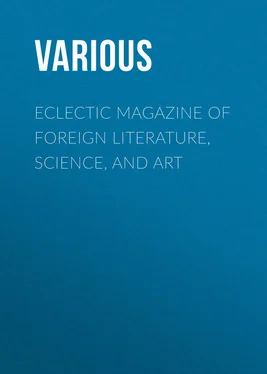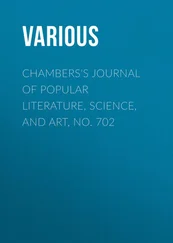Various - Eclectic Magazine of Foreign Literature, Science, and Art
Здесь есть возможность читать онлайн «Various - Eclectic Magazine of Foreign Literature, Science, and Art» — ознакомительный отрывок электронной книги совершенно бесплатно, а после прочтения отрывка купить полную версию. В некоторых случаях можно слушать аудио, скачать через торрент в формате fb2 и присутствует краткое содержание. Жанр: foreign_home, на английском языке. Описание произведения, (предисловие) а так же отзывы посетителей доступны на портале библиотеки ЛибКат.
- Название:Eclectic Magazine of Foreign Literature, Science, and Art
- Автор:
- Жанр:
- Год:неизвестен
- ISBN:нет данных
- Рейтинг книги:4 / 5. Голосов: 1
-
Избранное:Добавить в избранное
- Отзывы:
-
Ваша оценка:
- 80
- 1
- 2
- 3
- 4
- 5
Eclectic Magazine of Foreign Literature, Science, and Art: краткое содержание, описание и аннотация
Предлагаем к чтению аннотацию, описание, краткое содержание или предисловие (зависит от того, что написал сам автор книги «Eclectic Magazine of Foreign Literature, Science, and Art»). Если вы не нашли необходимую информацию о книге — напишите в комментариях, мы постараемся отыскать её.
Eclectic Magazine of Foreign Literature, Science, and Art — читать онлайн ознакомительный отрывок
Ниже представлен текст книги, разбитый по страницам. Система сохранения места последней прочитанной страницы, позволяет с удобством читать онлайн бесплатно книгу «Eclectic Magazine of Foreign Literature, Science, and Art», без необходимости каждый раз заново искать на чём Вы остановились. Поставьте закладку, и сможете в любой момент перейти на страницу, на которой закончили чтение.
Интервал:
Закладка:
Still more unexpected is the answer supplied to the question: Were the earth wholly denuded of its aëriform covering, what would be the temperature of its surface? We are informed in reply that it would be at the outside 50 degrees of Fahrenheit below zero, or 82 of frost. So that mercury would remain solid even when exposed to the rays – undiminished by atmospheric absorption – of a tropical sun at noon. 20 20 S. P. Langley, “Nature,” vol. xxvi. p. 316.
The paradoxical aspect of this conclusion – a perfectly legitimate and reliable one – disappears when it is remembered that under the imagined circumstances there would be absolutely nothing to hinder radiation into the frigid depths of space, and that the solar rays would, consequently, find abundant employment in maintaining a difference of 189 degrees 21 21 Sir J. Herschel’s estimate of the “temperature of space” was 239°F.; Pouillet’s 224°F. below zero. Both are almost certainly much too high. See Taylor, “Bull. Phil. Soc. Washington,” vol. ii. p. 73; and Croll, “Nature,” vol. xxi, p. 521.
between the temperature of the mercury and that of its environment. What we may with perfect accuracy call the clothing function of our atmosphere is thus vividly brought home to us; for it protects the teeming surface of our planet against the cold of space exactly in the same way as, and much more effectually than, a lady’s sealskin mantle keeps her warm in frosty weather. That is to say, it impedes radiation. Or, again, to borrow another comparison, the gaseous envelope we breathe in (and chiefly the watery part of it) may be literally described as a “trap for sunbeams.” It permits their entrance (exacting, it is true, a heavy toll), but almost totally bars their exit. It is now easy to understand why it is that on the airless moon no vapors rise to soften the hard shadow-outlines of craters or ridges throughout the fierce blaze of the long lunar day. In immediate contact with space (if we may be allowed the expression) water, should such a substance exist on our enigmatical satellite, must remain frozen, though exposed for endless æons of time to direct sunshine.
Amongst the most noteworthy results of Professor Langley’s observations in the Sierra Nevada was the enormous extension given by them to the solar spectrum in the invisible region below the red. The first to make any detailed acquaintance with their obscure beams was Captain Abney, whose success in obtaining a substance – the so-called “blue bromide” of silver – sensitive to their chemical action, enabled him to derive photographic impressions from rays possessing the relatively great wave-length of 1,200 millionths of a millimetre. This, be it noted, approaches very closely to the theoretical limit set by Cauchy to that end of the spectrum. The information was accordingly received with no small surprise that the bolometer showed entirely unmistakable heating effects from vibrations of the wave-length 2,800. The “dark continent” of the solar spectrum was thus demonstrated to cover an expanse nearly eight times that of the bright or visible part. 22 22 This is true only of the “normal spectrum,” formed by reflection from a “grating” on the principle of interference. In the spectrum produced by refraction, the red rays are huddled together by the distorting effect of the prism through which they are transmitted.
And in this newly discovered region lie three-fifths of the entire energy received from the sun – three-fifths of the vital force imparted to our planet for keeping its atmosphere and ocean in circulation, its streams rippling and running, its forests growing, its grain ripening. Throughout this wide range of vibrations the modifying power of our atmosphere is little felt. It is, indeed, interrupted by great gaps produced by absorption somewhere ; but since they show no signs of diminution at high altitudes, they are obviously due to an extra-terrestrial cause. Here a tempting field of inquiry lies open to scientific explorers.
On one other point, earlier ideas have had to give way to better grounded ones derived from this fruitful series of investigation. Professor Langley has effected a redistribution of energy in the solar spectrum. The maximum of heat was placed by former inquirers in the obscure tract of the infra-red; he has promoted it to a position in the orange approximately coincident with the point of greatest luminous intensity. The triple curve, denoting by its three distinct summits the supposed places in the spectrum of the several maxima of heat, light, and “actinism,” must now finally disappear from our text-books, and with it the last vestige of belief in a corresponding threefold distinction of qualities in the solar radiations. From one end to the other of the whole gamut of them, there is but one kind of difference – that of wave-length, or frequency in vibration; and there is but one curve by which the rays of the spectrum can properly be represented – that of energy, or the power of doing work on material particles. What the effect of that work may be, depends upon the special properties of such material particles, not upon any recondite faculty in the radiations.
These brilliant results of a month’s bivouac encourage the most sanguine anticipation as to the harvest of new truths to be gathered by a steady and well-organized pursuance of the same plan of operations. It must, however, be remembered that the scheme completed on Mount Whitney had been carefully designed, and in its preliminary parts executed at Alleghany. The interrogatory was already prepared; it only remained to register replies, and deduce conclusions. Nature seldom volunteers information: usually it has to be extracted from her by skilful cross-examination. The main secret of finding her a good witness consists in having a clear idea beforehand what it is one wants to find out. No opportunities of seeing will avail those who know not what to look for. Thus, not the crowd of casual observers, but the few who consistently and systematically think , will profit by the effort now being made to rid the astronomer of a small fraction of his terrestrial impediments. It is, nevertheless, admitted on all hands that no step can at present be taken at all comparable in its abundant promise of increased astronomical knowledge to that of providing suitably elevated sites for the exquisite instruments constructed by modern opticians.
Europe has not remained behind America in this significant movement. An observatory on Mount Etna, at once astronomical, meteorological, and seismological, was nominally completed in the summer of 1882, and will doubtless before long begin to give proof of efficiency in its threefold capacity. The situation is magnificent. Etna has long been famous for the amplitude of the horizon commanded from it and the serenity of its encompassing skies favors celestial no less than terrestrial vision. Professor Langley, who made a stay of twenty days upon the mountain in 1879-80, with the object of reducing to strict measurement the advantages promised by it, came to the conclusion that the “seeing” there is better than that in England (judging from data given by Mr. Webb) in the proportion of three to two – that is to say, a telescope of two inches aperture on Etna would show as much as one of three in England. Yet the circumstances attending his visit were of the least favorable kind. He was unable to find a suitable shelter higher up than Casa del Bosco, an isolated hut within the forest belt (as its name imports), at considerably less than half the elevation of the new observatory; the imperfect mounting of his telescope rendered observation all but impossible within a range of 30 degrees from the zenith, thus excluding the most serene portion of the sky; moreover, his arrival was delayed until December 25th, when the weather was thoroughly broken, high winds were incessantly troublesome, and only five nights out of seventeen proved astronomically available. It is, accordingly, reassuring to learn that while, with the naked eye, at ordinary levels, he could see but six Pleiades, with glimpses of a seventh and eighth, on Etna he steadily distinguished nine even before the moon had set; 23 23 Am. Jour. of Science, vol. xx. p. 36.
and that the telescopic definition though not uniformly good, was on December 31st such as he had never before seen on the sun, “least of all with a blue sky;” 24 24 Am. Jour. of Science, vol. xx. p. 41.
the “rice-grain” structure came out beautifully under a power of 212; and for the spectroscopic examination of prominences, the fainter orange light of their helium constituent served almost equally well with the strong radiance of the crimson ray of hydrogen (C) – a test of transparency which those accustomed to such studies will appreciate.
Интервал:
Закладка:
Похожие книги на «Eclectic Magazine of Foreign Literature, Science, and Art»
Представляем Вашему вниманию похожие книги на «Eclectic Magazine of Foreign Literature, Science, and Art» списком для выбора. Мы отобрали схожую по названию и смыслу литературу в надежде предоставить читателям больше вариантов отыскать новые, интересные, ещё непрочитанные произведения.
Обсуждение, отзывы о книге «Eclectic Magazine of Foreign Literature, Science, and Art» и просто собственные мнения читателей. Оставьте ваши комментарии, напишите, что Вы думаете о произведении, его смысле или главных героях. Укажите что конкретно понравилось, а что нет, и почему Вы так считаете.












